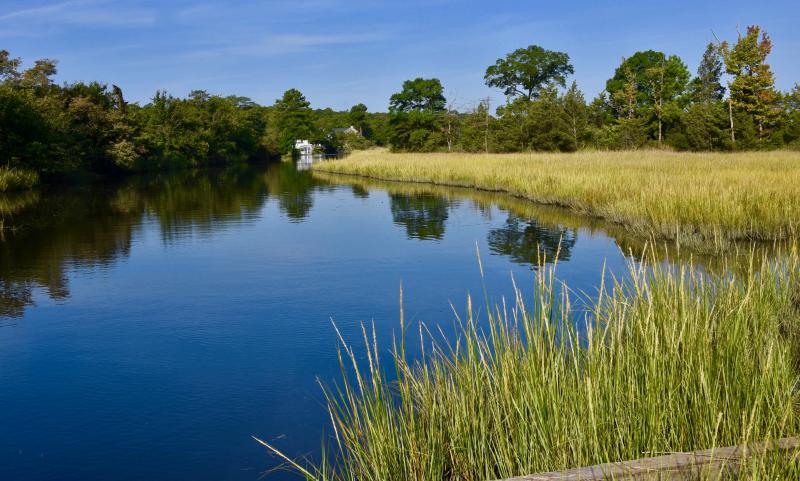During a Feb. 22 continuation of a Sussex County Council public hearing on proposed amendments to the wetland, water resources and drainage ordinance, council members heard many of the same comments made during the first hearing on Jan. 11.
Now, council has a voluminous public record and more than six hours of testimony to consider as it contemplates whether to make any amendments to the ordinance or to vote on it as currently written.
Sussex County Planning and Zoning Commission has recommended that council approve the ordinance.
Many of those who testified said council should consider removing any provisions that allow developers to decrease buffer widths (Section G of the ordinance), require buffers be wooded with mature trees preserved or reforested, and provide a spelled-out enforcement policy with sufficient penalties for violations of the ordinance.
One area of contention is how to incentivize landowners and developers not to clear-cut wooded parcels along wetlands and waterways prior to filing an application.
Speakers during the hearing said other jurisdictions place time restrictions of up to five years before an application can be filed if clear-cutting occurs.
SARG survey results
Tom Goglia, representing the Sussex Alliance for Responsible Growth, presented results of a survey conducted by the grassroots organization.
Since the presentation, SARG has received another 200 responses with more than 500 comments. Results included the following:
1. How concerned are you about the impact of development on our wetlands and waterways?
Very concerned, 97 percent; somewhat concerned, 2 percent.
2. The protection and retention of existing forested buffers and the re-planting of trees in non-forested buffers is the best buffer and provides maximum protection to our waterways, wetlands and habitats.
Strongly agree, 90.9 percent; agree, 7.8 percent; disagree and no opinion, less than 1 percent.
3. Section G of the proposed ordinance should be deleted as it would allow developers to reduce the buffers within the proposed subdivision, in some cases below today's standards, or reduce buffers in exchange for creating buffer alternatives outside the entire subdivision.
Strongly agree, 93 percent; agree, 3 percent; disagree, 3 percent.
4. At a minimum, the county should approve the expanded buffer widths as recommended by the buffer work group and not allow for any net buffer reductions.
Strongly agree, 94 percent; agree, 5 percent; disagree, 1 percent.
5. The county should add strong enforcement provisions and penalties for noncompliance to the ordinance to ensure that its provisions are taken seriously and lead to meaningful improvement in the quality of waterways, wetlands and habitat.
Strongly agree, 96 percent; agree, 3 percent; disagree, 1 percent.
Goglia said SARG recommends elimination of Section G, approval of the expanded buffer widths as proffered by the working group, and establishment of an enforcement vehicle that provides for appropriate penalties for violations, which would elevate constituents’ confidence that the ordinance will accomplish its intended purpose. He said recommendations also include that council should read the comments accompanying the survey. “They are serious, well-reasoned and passionate,” he said.
Pass ordinance as written
Not everyone who spoke said amendments should be made to the ordinance.
R.C. Willin, a Seaford-area farmer and working group member, said council should pass the ordinance as written and address concerns brought up in the hearings at a future date.
“This ordinance is not the answer to everything, but it's a tremendous step forward,” he said. “What the working group handed to county council can make a difference that will last for many years.”
He said many provisions in the ordinance will make a difference.
Willin said he supports 100-foot buffers along tidal wetlands and waterways.
“We want to be close to water. How do we allow that and still protect the resource?” he asked. “This ordinance does this.”
Buffer management and access to buffers for maintenance are also included in the ordinance, he said.
However, Willin spoke at length about grasslands or meadows with a mixture of trees as a buffer alternative.
“You have to consider something other than just forested buffers,” Willin said. “Grasses would help maintain the viability of a wooded buffer. A wooded buffer alone is not the answer.”
He said a grass buffer along waterways slows down wave action and traps sediment, which can raise elevations to better protect properties. He said Maryland officials are using grass buffers in an effort to build up Smith Island, which is in jeopardy of being overtaken by the Chesapeake Bay.
He said although the working group kept water quality first and foremost in discussions, the long-term viability of wetlands and waterways was not discussed enough.
Willin presented several photographs of the Horse Pen Creek area near Seaford where trees are dying and falling into the water as an example of what can happen to a trees-only buffer where flowing water undermines trees’ root systems.
Provisions for better buffer management and access for maintenance are also included in the ordinance, he said.
Remove Section G
Bethany Beach Mayor Rosemary Hardiman said she agreed with the concerns expressed by the Delaware Center for the Inland Bays. She said there should be incentives to preserve forested areas and replanting trees in the buffer area. The mayor said any regulations allowing buffers to be reduced should be rejected. “If there's any change, it should be an increase [in buffer width], not a decrease,” she said.
In addition, she said, enforcement of the ordinance should be more clearly spelled out.
She noted that the county's 2018 comprehensive plan states that the protection of wetlands and waterways is important to the environment and economy.
Chip Smith, representing the Bethany Beach Landowners Association, said Section G of the ordinance should be eliminated.
Smith said wetland buffers should be required to have existing trees preserved or new ones planted, because grasslands and vegetated buffers do not function as well. He said the ordinance should contain a statement that mature trees can't be cut down.
Jill Hicks, who co-owns beach property in Lewes, said a perfect example of how untouched wetlands function are the large marshes along the Lewes-Rehoboth Canal that protect people's properties.
She agreed with others that Section G of the ordinance should be removed. “This only gives land developers more leeway to destroy resources; it's a step backward. If Section G remains, I would recommend a failing grade,” the retired educator said.




















































